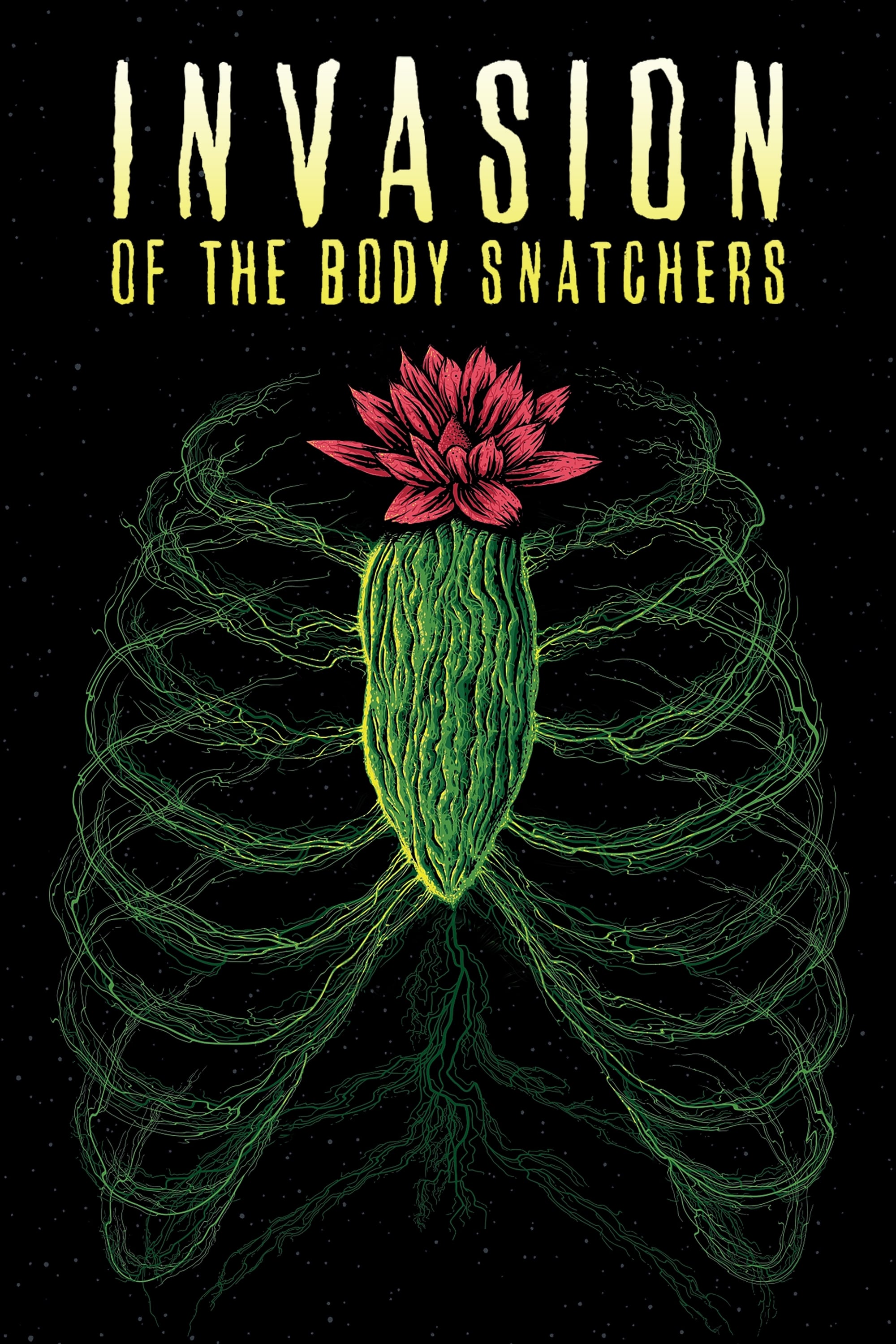As superbly pointed out by Thomas Ligotti, Don Siegel's "Invasion of the Body Snatchers" (but even more the Philip Kaufman remake) and John Carpenter's "The Thing" bring to the big screen one of the most disturbing ghosts of our time, which we could define the triple "spectrum of dehumanization": dehumanization of the human species due to the invasive action of an alien agent; dehumanization of the human community towards one's fellow men; dehumanization of the human individual in its most intimate aspect.
di Marco Maculotti
cover: "Invasion of the Body Snatchers" poster, 1978
The story of Invasion of the Body Snatchers (film by Don Siegel, released in theaters in 1956) is known, and the 1978 remake by Philip Kaufman he takes it back slavishly. Elizabeth (Brooke Adams) confides to friend Matthew (Donald Sutherland), sanitation inspector in San Francisco restaurants, who for a few days her husband suddenly appears changed, as if he were another person; meanwhile, similar testimonies emerge throughout the city. The story becomes more and more strange when Jack and Nancy, two of their friends, find in the public sauna where the latter works a strange being, similar to a corpse but incomplete like a fetus, sprinkled all over the body by a strange white hair.
It won't take long to figure that out the city is invaded by alien creatures which, developing from a flower and maturing into a pod, take on the appearance of their human targets after having "absorbed" them, and then replace them. This is, as Thomas Ligotti points out, "the recurring motif of supernatural horror", which we can also find in many films of David Cronenbergin Village of the Damned by Wolf Rilla (1960) and, as we will see later, ne The thing by John Carpenter [1]:
« something terrible in its essence comes and makes its claims as a shareholder in our reality, or in what we think is our exclusive reality. »
Nonetheless, compared to the original, the Kaufman remake carried the story from a small town in the States rural a San Francisco, symbol ultimate of the great metropolis of the post-cultural revolution New America (and sexual), with the stated intent to increase perspective Babelic and depersonalizing the story. In this way, while maintaining a critical message towards the US political and community dimension, compared to the original film, the remake shifts the target from McCarthyism / communism to individualism /apparitionism of the post-Nixonian and post-Ford era of the late seventies. The world, in front of Hollywood cinemas no less than in real life, was starting to be increasingly framed as a mere theatrical representation, in which the individual became more and more blissfully an actor's mask: i hippies they had "matured" and within a decade had turned into yuppies; from being one passed into existence, from understanding to mere appearing.

In other words, Kaufman seems to want to demonstrate how it is possible to witness a snap of his fingers sudden and inconsistent abandonment of ideals and feelings until recently considered essential, in favor of an unbridled and selfish individualism. Rather current arguments at the time of writing, in which the terror of the circulation of a virus whose effects are not yet fully known - favored by the ambiguity and contradiction of the political measures adopted in order to govern its spread - seems to bring out the worst of the masses, more and more adrift in a shipwreck than before it is behavioral or cultural ontological, mirror of our times.
In Terror from deep space, released in cinemas now more than forty years ago, this one dehumanization of the individual (and of the masses, which are basically nothing but agglomerations of individuals) emerges on several levels: first, obviously, on a merely "science fiction" or "supernatural" level, in the narrative expedient of people "possessed" by the body snatchers from sidereal space, and consequently now deprived of their humanity, empty simulacra which, although appearing apparently identical to before the transformation took place, no longer present anything of human. As it notes Thomas Ligotti, underlining the disturbing elements ofInvasion of the Body Snatchers in his non-fiction work The conspiracy against the human race [2]:
"What is alien power doing on our planet?" He comes to prolong the survival of his species by recreating it in our image. So let's just know this about its mechanics and intentions: is equal to us, except that it threatens to replace the survival and reproduction of our species with the survival and reproduction of its. The methodology of this alien power is to create our duplicates while we sleep, preventing us from awakening in our own shoes, transforming us into a completely different kind of being. "

Note this peculiarity of "alien possession", which Ligotti masterfully underlines: the ultra-body, although "it does not derive [i] from the human world but from foreign and enigmatic spheres", adapts itself to our species, to the point of giving up its own body (which apparently does not even possess, like a real virus) to take possession of ours. Even the ultimate purposes of the alien parasite do not differ much, ultimately, from those of the human race: survives e reproduce; if needed, even to the detriment of any form of life that competes for survival and reproduction.
And here we come to a second level of interpretation, which can also be observed in the situation we find ourselves living in these days: from another perspective the dehumanization of humanity occurs on a non-science fiction level, but merely sociological: Once psychosis begins to spread, no individual trusts his neighbor more, even suspecting wives and husbands, parents and siblings: in emergencies it is confirmed as never before that homo homini lupus. Even after the transformation into body snatchers, this informer instinct does not fail: to the point that humans now possessed by the alien virus signal to their fellow humans those who are still immune to transmutation, uttering repulsive cries and pointing at the unfortunate with bulging eyes, to sometimes proceed to real lynchings [3].
In addition, even more so in a large metropolis like San Francisco, everyone is virtually a stranger in the eyes of others and no one is truly able to recognize the subtle inner changes that occur in people walking down the street a few meters from each other. : ultra-bodied or not, we've all become strangers to ourselves, with each other and ourselves with ourselves. Here is one reason among many that makes the remake of '78 even more terrifying (and realistic, as well as current) than the original of the fifties. Let's once again give the floor to Ligotti, who thus continues his analysis of the film [4]:
“Because of these transformations, anyone who has fallen victim to the body snatchers is consumed by two frightening doubts. The first is that anyone else may not be what they seem: human. The other is that he himself risks transformation by falling asleep. "

Analyzed in a sociological as well as science fiction key, the story narrated in it The Invasion of the Body Snatchers assumes a new value even more gruesome for those who know how to read between the lines: it is colored with dark colors becoming the allegory of a period dominated not only by individualism, alienation and reach but also by paranoia, enemy demonization and conspiracy theories, as well as the spread of apocalyptic visions and extremist sects and groups that make absolute irrationality their own manifesto - the same year in which Terror from deep space released in theaters, the hallucinating collective suicide of Jonestown took place, without forgetting the political assassinations that ravaged the entire decade of the '70s.
And yet in the narrative plot ofInvasion of the Body Snatchers - in the remake of Kaufman even more than in the original - we can also identify a third level, also dutifully underlined by Ligotti. In fact, if before the transformation into an ultra-body occurs, humans seem to struggle with all the strength and determination they have to maintain their humanity, which alone distinguishes them from the already "infected" associates, once it has occurred it is not experienced this way. evil from the "possessed", who indeed are grateful to have renounced one's humanity in exchange for the eternal peace of mind that awaits those who want to strip themselves of their most intimate being or, to put it in other words, of one's soul. It would therefore be - we paraphrase - of a modern update of the topos of the "surrender of the soul"To a demonic force [5]:
“Unlike the vampire or the zombie, states of existence are anything but desirable, the transformation into body snatchers - which despite appearing in the plural in the title of the film they resemble elements of a beehive more than unique and identifiable entities - doesn't look so bad, on an objective level. Once absorbed by the alien power, converts lose their human qualities except one: satisfaction, or happiness, if you prefer. In their existence they become quietists […]. It's a fate worse than death: the transformation where you stop being yourself. It is better to die than to live integrated, even if integrated life is a life of permanent and reassuring calm, no longer vulnerable to fear and disgust. »

Virus or non-virus, alien invasion or not, Terror from deep space it thus seems, in the final analysis, to envisage an eventuality which, despite being technically framed as a whole human, appears even more terrifying than the renunciation of our peculiar humanity by virtue of being absorbed into something non-human: namely the speculating renunciation of the emotions, passions and differences that make us truly human, in exchange for an unconditional adherence to a super-individual and unipolar system, in which the yearning for an aseptic nirvana ultimately results in not getting excited anymore, no longer loving or even hating: not thinking with your own mind, much less opposing the abuses and what, humanly, we do not consider it acceptable.
In a topical scene of Kaufman's remake, a friend of the protagonist now "possessed" by the protoplasmic alien force invites the aforementioned Matthew to renounce what distinguishes him as a human being, to become in effect one of them, the only "citizenship "That will be allowed in the world to come, in which every decision will be made by the formless super-individual Mind of the ultra-body which, invisible, will psychically govern the entire hive formed by the now" alienated "human beings: «There is no longer any need for hate or love ", she says to convince him, staring into his eyes with a smile now devoid of any humanity. «Don't fossilize in outdated concepts: we are evolving into a new form of life».
This third level of reading appears, at the time of writing, if possible even more meaningful and current than the second: in a world where all opinions are labeled, cataloged in the form of slogans and dichotomized as much as possible - a process that inevitably leads to a carnival trivialization and a forced flattening of any vision and opinion, however legitimate and worthy of interest it may be -, the dehumanization of the entire human consortium and its abdication in thinking and forming opinions worthy of the name, delegating them to a granitic and super-individual Authority, appears more and more frighteningly similar to that, exposed from a science fiction perspective, of Kaufman's film.

In this regard, Ligotti extends his analysis to another essential film of those years, also ascribable to the trend of "supernatural horror": The Thing by John Carpenter, released in 1982. Also, similarly to all'Invasion of the body snatchers, turns out to be an excellent vector of the three levels of interpretation concerning what we could define the triple "specter of dehumanization", which we covered with regard to Kaufman's film: dehumanization of the human species due to the invasive action of an alien agent; dehumanization of the human community towards one's fellow men; dehumanization of the human individual in its most intimate aspect.
We therefore leave the final word to Thomas Ligotti at the conclusion of these brief observations which today appear so relevant today [6]:
“In its ontological scheme, John Carpenter's 'The Thing' looks a lot like 'Invasion of the Body Snatchers'. The reasons for the Thing are the same: to survive and reproduce. Only the method is different, and the result is an altogether greater degree of disturbance. Since the creature protagonist of the film is able to reshape itself with the appearance of any form of life, the characters can never distinguish who is a "thing" from who is not., since the victim of thethe transformation retains its appearance, its memories and its behavior even after it has essentially become a disturbing monstrosity from another world. This situation leads the members of the Antarctic research station […] to question the identity of the comrades: who is a Thing, and who is the usual individual? Of course, those at the station are dedicated to repressing any consciousness of being a "thing", just as those who witness an epileptic attack devote themselves to the thought of not being a set of parts made as they are made, a clockwork process rather than an immutable being whose essence does not change.
Through isolation (taking this possibility out of his head) the witness retains the feeling of being an idealized, integral and undivided entity, not a mechanism, a human puppet that does not recognize itself as such.. He can also distract himself from the shocking news about human beings by watching a film in which the characters are victims of a perturbing fate which, however, cannot occur at all in real life, being represented in the form of an invasion from "alien and enigmatic spheres" that the viewer considers detached from our world, the world where we know who we are and who the others are: members of a species that exists to survive and reproduce, ordinary people who have nothing to do with supernaturalism and the uncanny, who remain impervious to the pessimism of stories like "The Invasion of the Body Snatchers" and "The Thing", whose protagonists die or are deformed by the battle to defend their lives and humanity »

Note:
[1] LIGOTTI, Thomas: The conspiracy against the human race, Il Saggiatore, Milan 2016, p. 51
[2] Ibid, p. 82
[3] The man hit by the car and lynched is, however, Kevin McCarthy, protagonist of the original 1956 film by Don Siegel, who appears here only in this cameo.
[4] LIGOTTI, op. cit., p. 82
[5] Ibid, pp. 82-83
[6] Ibid, pp. 83-84

6 comments on “From "The invasion of the body snatchers" to "The Thing": infection, possession and dehumanization"